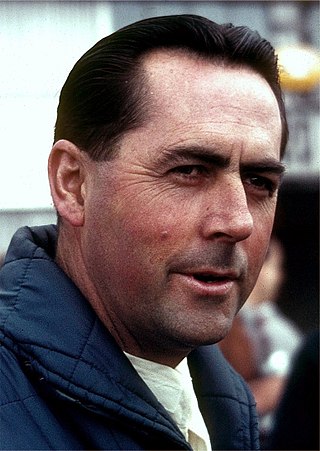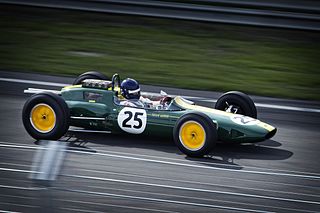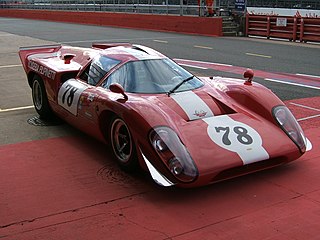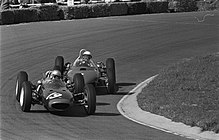
John Norman Surtees was a British racing driver and motorcycle road racer, who competed in Grand Prix motorcycle racing from 1952 to 1960, and Formula One from 1960 to 1972. Surtees was a seven-time Grand Prix motorcycle World Champion, with four titles in the premier 500cc class with MV Agusta. Surtees won the Formula One World Drivers' Championship in 1964 with Ferrari, and remains the only driver to win World Championships on both two- and four-wheels; he won 38 motorcycle Grands Prix and six Formula One Grands Prix.
Lola Cars Limited is a British automobile manufacturer founded in 1958 by Eric Broadley in Bromley, England. The company is now owned by Till Bechtolsheimer, which he purchased in 2022. Lola Cars endured for more than fifty years to become one of the oldest and largest manufacturers of racing cars in the world. Lola started by building small front-engine sports cars, and branched out into Formula Junior cars before diversifying into a wider range of sporting vehicles. In 2012, Lola Cars stopped operations. Lola is set to make a return to motorsport in 2024 by joining the Formula E World Championship as an entrant and a powertrain supplier in a technical partnership with Yamaha.

Coventry Climax was a British manufacturer of forklift trucks, fire pumps, racing engines, and other speciality engines.

The 1966 Formula One season was the 20th season of FIA Formula One motor racing. It featured the 17th World Championship of Drivers, the 9th International Cup for F1 Manufacturers, and four non-championship races open to Formula One cars. The World Championship was contested over nine races between 22 May and 23 October 1966.

The 1964 Formula One season was the 18th season of FIA Formula One motor racing. It featured the 15th World Championship of Drivers, the 7th International Cup for F1 Manufacturers, and eight non-championship races open to Formula One cars. The World Championship was contested over ten races between 10 May and 25 October 1964.

The 1962 Formula One season was the 16th season of FIA Formula One motor racing. It featured the 13th World Championship of Drivers, the 5th International Cup for F1 Manufacturers, and numerous non-championship Formula One races. The World Championship was contested over nine races between 20 May and 29 December 1962.

Reginald Parnell was a racing driver and team manager from Derby, England. He participated in seven Formula One World Championship Grands Prix, achieving one podium, and scoring a total of nine championship points.

The Lotus 25 was a racing car designed by Colin Chapman for the 1962 Formula One season. It was a revolutionary design, the first fully stressed monocoque chassis to appear in Formula One. In the hands of Jim Clark it took 14 World Championship Grand Prix wins and propelled him to his 1963 World Championship title. Its last World Championship win was at the 1965 French Grand Prix.

The MasterCard Lola Formula One Racing Team, often known as MasterCard Lola or simply Lola, was a British Formula One team that contested only one race in the 1997 Formula One World Championship. It quickly withdrew from the sport after failing to qualify on its debut at the 1997 Australian Grand Prix, where the cars were more than 11 seconds off the pace in qualifying.

The Lola T70 is a sports prototype developed by British manufacturer Lola Cars in 1965, the successor to its Mk6. Lola built the aluminium monocoque chassis, which were typically powered by large American V8s.
Reg Parnell Racing was a privateer Formula One team during the 1950s and 1960s. The team was founded by ex-Formula One driver Reg Parnell after he retired from racing. It raced as Yeoman Credit Racing in 1961 and as the Bowmaker Racing Team in 1962. The team's best results were a pair of second places in the British Grand Prix and the German Grand Prix of 1962. John Surtees also took pole for the team at the 1962 Dutch Grand Prix.

Yeoman Credit Racing was a name used by two different Formula One motor racing teams in the early-1960s: the British Racing Partnership (1960); and Reg Parnell Racing (1961–62). The name was derived from commercial sponsorship arrangements, the first time that a Formula One racing team had changed their name in deference to sponsorship.

The Honda RA300 was a Formula One racing car produced by Honda Racing, and introduced towards the end of the 1967 Formula One season. It retained the same V12 engine as the preceding RA273 car, but the chassis was designed by Lola's Eric Broadley thanks to Honda driver John Surtees' experiences driving a Lola T70 in the Can-Am championship. The new chassis was based on a previous Lola Indianapolis 500 car, the T90. Internally, Lola designated the RA300 the T130. This collaboration resulted in the machine quickly being dubbed the "Hondola" by the motorsports press.
Eric Harrison Broadley MBE was a British entrepreneur, engineer, and founder and chief designer of Lola Cars, the motor racing manufacturer and engineering company. He was arguably one of the most influential automobile designers of the post-war period, and over the years Lola was involved with many high-profile projects in Formula One, Indy car, and sports car racing. Broadley sold Lola to Martin Birrane in 1997.

The BRM P261, also known as the BRM P61 Mark II, is a Formula One motor racing car, designed and built by the British Racing Motors team in Bourne, Lincolnshire, England. The BRM P261 was introduced for the 1964 Formula One season, and its design was an evolution of Tony Rudd's one-off BRM P61 car of 1963. The P261 had a relatively long racing career; variants of the car were still being entered for Formula One World Championship Grands Prix as late as 1968. During the course of their front-line career, BRM P261s won six World Championship races, in the hands of works drivers Graham Hill and Jackie Stewart, and finished second in both the Drivers' and Constructors' Championship standings in 1964 and 1965. Stewart, Hill and Richard Attwood also used works P261s to compete in the Tasman Series in 1966. The BRMs dominated, with Stewart winning four, Hill two, and Attwood one of the 1966 Tasman Series' eight races. Stewart also won the title. The works-backed Reg Parnell Racing team returned in 1967 with Stewart and Attwood, where Stewart added another two wins to his tally. In terms of races won and total championship points scored, the P261 was the most successful car in BRM's history.

The Brabham BT3 is a Formula One racing car. It was the first Formula One design to be produced by Motor Racing Developments for the Brabham Racing Organisation, and debuted at the 1962 German Grand Prix. The Brabham BT3 was the vehicle with which team owner – then two-time World Champion – Jack Brabham, became the first driver ever to score World Championship points in a car bearing his own name, at the 1962 United States Grand Prix. The following year Brabham also became the first driver ever to win a Formula One race at the wheel of an eponymous car, again driving the BT3, at the 1963 Solitude Grand Prix. The BT3 design was modified only slightly to form the Tasman Series-specification Brabham BT4 cars.

The Lola Mk6 GT was a racing car with a production run of only three units, built between 1962 and 1963 by British car manufacturer Lola Cars. With its 289 cu in (4.74 L) Ford V8 engine, the Mk6 GT was the first mid-mounted, high displacement V8-powered Grand Touring car, a chassis arrangement that had been used, up until that time, only on formula cars and smaller, more affordable GTs.

The Cooper-Climax T55 is a Formula One car built by the Cooper Car Company for the 1961 Formula One season. Its best result was third-place for Bruce McLaren at the 1961 Italian Grand Prix.
The Cooper T58 was a Formula One car built by Cooper Car Company for the 1961 Formula One season. Only one example was built; it set one pole position and one fastest lap but scored no wins.

The Cooper T60 is a Formula One racing car from the Cooper Car Company, which was in use from 1962 to 1965. It won a single World Championship Grand Prix, the 1962 Monaco Grand Prix, driven by Bruce McLaren.

















